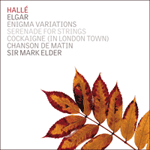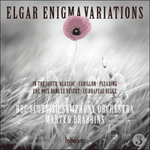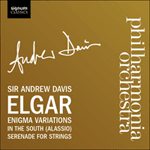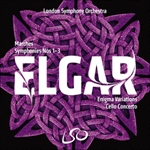
Welcome to Hyperion Records, an independent British classical label devoted to presenting high-quality recordings of music of all styles and from all periods from the twelfth century to the twenty-first.
Hyperion offers both CDs, and downloads in a number of formats. The site is also available in several languages.
Please use the dropdown buttons to set your preferred options, or use the checkbox to accept the defaults.

Like most overnight successes, Elgar had worked hard for years to achieve this recognition—he was forty-two years old when he completed the work. Elgar’s mastery of the time-honoured device of theme and variations invited comparisons with the greatest classical masters, yet it was his uniquely personal approach to the form that was to give the Enigma its initial novelty and lasting appeal.
Elgar himself recalled to a friend how the Variations came to be conceived on the evening of 21 October 1898, when ‘after a long day’s fiddle teaching’, he lit a cigar and sat down at the piano:
In a little while, soothed and feeling rested, I began to play, and suddenly my wife interrupted by saying, ‘Edward, that’s a good tune.’ I awoke from the dream: ‘Eh! tune, what tune!’ and she said, ‘Play it again, I like that tune.’ I played and strummed, and played, and then she exclaimed, ‘That’s the tune.’ And that tune is the theme of the Variations.
Elgar’s daughter Carice later recounted the same incident, explaining that Elgar had gone on to extemporize variations illustrating the characters of various family friends. So the grand scheme was fixed at the outset: thirteen variations, thirteen musical sketches of ‘my friends pictured within’, as the dedication eventually ran, and a finale representing the composer himself.
Before the first performance, Elgar stated:
The ‘Enigma’ I will not explain—its ‘dark saying’ must be left unguessed, and I warn you that the apparent connection between the Variations and the Theme is often of the slightest texture; further, through and over the whole set another and larger theme ‘goes’, but is not played …
More words have probably been spilled over these sentences than on any other Elgarian topic, each of the dozens of proposed solutions merely adding another layer of mystery to an already ambiguous pronouncement. Nevertheless, the basic facts of the Enigma’s inception are reasonably clear: Elgar finished the work in February 1899, initially sending the score not to Novello, his publisher, but to Richter. August Jaeger, Elgar’s editor at Novello, received it in April. At this time the word ‘Enigma’ did not appear anywhere in the score and it was Jaeger himself who wrote it above the beginning of the theme. This could mean that either Elgar asked him to add it, or that it was Jaeger’s (or even Richter’s) idea in the first place; we do not know. In any case it does appear that the name was an afterthought. Certainly, the title applied only to the theme itself and not to the whole work, as was made clear by Elgar himself in a programme note in 1911:
This work, commenced in a spirit of humour & continued in deep seriousness, contains sketches of the composer’s friends. It may be understood that these personages comment or reflect on the original theme & each one attempts a solution of the Enigma, for so the theme is called.
Finally, in a letter to Ernest Newman written in 1912, Elgar said that the Theme ‘expressed when written (in 1898) my sense of the loneliness of the artist … and to me, it still embodies that sense’.
The succeeding variations are:
I: C.A.E. Caroline Alice Elgar—a tender and dignified portrait of the woman who made Elgar the composer he was.
II: H.D.S.-P. Hew David Steuart-Powell—amateur pianist and lover of chamber music.
III: R.B.T. Richard Baxter Townshend—writer and amateur actor.
IV: W.M.B. William Meath Baker—a country squire with a somewhat bluff manner.
V: R.P.A. Richard P Arnold—son of Matthew Arnold. A man whose ‘serious conversation was continually broken up by whimsical and witty remarks’.
VI: Ysobel Isabel Fitton—an amateur viola player, whose struggle with ‘string-crossing’ on the instrument is gently parodied here.
VII: Troyte Troyte Griffith—Malvern architect and occasional (and unsuccessful) piano pupil of Elgar’s.
VIII: W.N. Winifred Norbury—this variation is not just a portrait of Winifred Norbury but also of the elegant eighteenth-century house in which she lived.
IX: Nimrod August Jaeger—Elgar’s publisher; the man who probably understood Elgar better than the composer understood himself. This famous variation was apparently inspired by a conversation the two men had about the slow movement of Beethoven’s ‘Pathétique’ piano sonata.
X: Dorabella Dora Penny—a young friend of the Elgars, who later wrote a revealing memoir of the composer.
XI: G.R.S. George Robertson Sinclair—organist of Hereford Cathedral and his bulldog Dan. In Elgar’s words, the opening illustrates ‘Dan falling down the steep bank into the river Wye (bar 1); his paddling upstream to find a landing place (bars 2 and 3); and his rejoicing bark on landing (2nd half of bar 5)’.
XII: B.G.N. Basil G Nevinson—an amateur cello player much admired by Elgar.
XIII: *** Romanza According to Elgar: ‘The asterisks take the place of the name of a lady who was, at the time of the composition, on a sea voyage.’ Long thought to have been identified with Lady Mary Lygon, the variation is now believed by many to refer to Helen Jessie Weaver, who broke off her engagement to Elgar in 1884 and later emigrated to New Zealand.
XIV: E.D.U. Finale ‘Edu[ard]’—Alice’s pet name for her husband. A bold and splendid self-portrait of the man himself, surrounded by the friends he loved the most.
from notes by John Pickard © 2016
Comme pour la plupart des succès immédiats, Elgar avait dû travailler dur des années durant pour être reconnu—il avait quarante-deux ans lorsqu’il acheva cette œuvre. Sa maîtrise du procédé consacré par l’usage, le thème et variations, incitait à faire des comparaisons avec les plus grands maîtres classiques, mais c’est son approche éminemment personnelle de la forme qui allait donner aux Variations «Enigma» l’attrait de la nouveauté et leur charme durable.
Elgar lui-même rappela à un ami comment il en vint à concevoir les Variations au cours de la soirée du 21 octobre 1898, lorsque «après une longue journée d’enseignement du violon», il alluma un cigare et s’assit au piano:
En un instant, apaisé et me sentant reposé, j’ai commencé à jouer et, soudain, ma femme m’a interrompu en disant: «Edward, c’est un bel air.» Je suis sorti du rêve: «Hein! un air, quel air!» et elle a dit: «Rejoue-le, j’aime cet air.» J’ai joué et joué doucement, et joué, et alors elle s’est exclamé: «C’est l’air.» Et cet air est le thème des Variations.
La fille d’Elgar, Carice, raconta ensuite le même incident, en expliquant qu’Elgar avait continué à improviser des variations illustrant le caractère de divers amis de la famille. Le plan grandiose était donc fixé d’emblée: treize variations, treize esquisses musicales de «mes amis qui s’y trouvent portraiturés», comme fut finalement libellée la dédicace, et un finale représentant le compositeur lui-même.
Avant la première exécution, Elgar spécifia:
L’«Enigme» je ne l’expliquerai pas—son «sombre adage» doit être laissé insoupçonné, et je vous préviens que le lien apparent entre les variations et le thème est souvent très mince; en outre, dans toute l’œuvre un autre thème plus important «existe», mais il n’est pas joué …
Ces phrases ont sans doute donné lieu à bien plus de commentaires que tout autre sujet elgarien, chaque nouvelle solution proposée ajoutant juste une autre couche de mystère à une déclaration déjà ambiguë. Néanmoins, les éléments de base des origines des Variations «Enigma» sont relativement clairs: Elgar termina cette œuvre en février 1899; au départ, il n’envoya pas la partition à Novello, son éditeur, mais à Richter. August Jaeger, l’éditeur d’Elgar chez Novello, la reçut en avril. À cette date, le mot «Enigma» n’apparaissait nulle part dans la partition et c’est Jaeger lui-même qui l’écrivit au-dessus du début du thème. Ceci pourrait vouloir dire soit qu’Elgar lui demanda de l’ajouter, soit que c’était l’idée de Jaeger (ou même de Richter) en premier lieu; on l’ignore. En tout cas, il ne semble pas que ce titre soit une idée après coup. Il ne s’appliquait certainement qu’au thème lui-même et pas à l’ensemble de l’œuvre, comme l’expliqua clairement Elgar lui-même dans un programme en 1911:
Cette œuvre, commencée dans un esprit humoristique & poursuivie dans une profonde gravité, contient des esquisses d’amis du compositeur. On peut comprendre que ces personnages font des commentaires sur le thème original ou réfléchissent à ce thème & chacun tente de trouver une solution à l’Énigme, car c’est ainsi que s’appelle le thème.
Finalement, dans une lettre adressée à Ernest Newman écrite en 1912, Elgar dit que le thème «exprimait lorsqu’il fut écrit (en 1898) mon sentiment de solitude de l’artiste … et pour moi, il incarne toujours ce sentiment». Les variations successives sont:
I: C.A.E. Caroline Alice Elgar—un portrait tendre et empreint de dignité de la femme qui a fait d’Elgar le compositeur qu’il était.
II: H.D.S.-P. Hew David Steuart-Powell—un pianiste amateur et amateur de musique de chambre.
III: R.B.T. Richard Baxter Townshend—écrivain et acteur amateur.
IV: W.M.B. William Meath Baker—un gentilhomme campagnard assez carré.
V: R.P.A. Richard P. Arnold—fils de Matthew Arnold. Un homme dont «la conversation sérieuse était sans cesse interrompue par des remarques sarcastiques et pleines d’esprit».
VI: Ysobel Isabel Fitton—une altiste amateur, dont les problèmes posés par «le passage d’une corde à une autre» sur son instrument sont gentiment parodiés ici.
VII: Troyte Troyte Griffith—un architecte de Malvern et élève de piano occasionnel (et aux efforts infructueux) d’Elgar.
VIII: W.N. Winifred Norbury—cette variation n’est pas seulement un portrait de Winifred Norbury mais également de l’élégante demeure du XVIIIe siècle dans laquelle elle vivait.
IX: Nimrod August Jaeger—éditeur d’Elgar; l’homme qui a probablement mieux compris Elgar que le compositeur se comprenait lui-même. Cette célèbre variation fut apparemment inspirée par une conversation qu’avait eu les deux hommes à propos du mouvement lent de la Sonate pour piano «Pathétique» de Beethoven.
X: Dorabella Dora Penny—une jeune amie des Elgar, qui écrivit plus tard une notice biographique révélatrice du compositeur.
XI: G.R.S. George Robertson Sinclair—organiste de la cathédrale d’Hereford et son bouledogue Dan. Selon Elgar, le début illustre «Dan qui tombe de la rive abrupte dans la rivière Wye (mesure 1); nage à contre-courant à la recherche d’un endroit où il puisse aborder (mesure 2 et 3) et aboie joyeusement lorsqu’il touche terre (seconde moitié de la mesure 5)».
XII: B.G.N. Basil G. Nevinson—violoncelliste amateur qu’Elgar admirait beaucoup.
XIII: *** Romanza Selon Elgar: «Ces astérisques remplacent le nom d’une dame qui, au moment de la composition, faisait un voyage en mer.» Longtemps identifiée comme étant Lady Mary Lygon, nombreux sont ceux qui croient maintenant que cette variation fait allusion à Helen Jessie Weaver, qui rompit ses fiançailles avec Elgar en 1884 et émigra par la suite en Nouvelle-Zélande.
XIV: E.D.U. Finale ‘Edu[ard]’—petit nom qu’Alice donnait à son mari. Un autoportrait audacieux et magnifique de l’homme lui-même, entouré des amis qu’il aimait le plus.
extrait des notes rédigées par John Pickard © 2016
Français: Marie-Stella Pâris
Wie es bei den meisten Blitzerfolgen der Fall ist, hatte auch Elgar über viele Jahre hinweg hart daran gearbeitet, diese Anerkennung zu erreichen—er war 42 Jahre alt, als er das Werk fertigstellte. Elgars kunstvolle Beherrschung der altehrwürdigen Form des Themas mit Variationen brachte ihm Vergleiche mit den größten klassischen Meistern ein, doch war es seine einzigartige und individuelle Handhabung dieser Form, welche den Enigma-Variationen ihre anfängliche Neuartigkeit und anhaltende Anziehungskraft verleihen sollte.
Elgar selbst erzählte einem Freund, wie ihm die Variationen am 21. Oktober 1898 nach „einem langen Tag des Geigenunterrichtens“ erstmals in den Sinn gekommen waren, als er sich abends eine Zigarre anzündete und sich ans Klavier setzte:
Nach einer Weile, als ich mich etwas erholt und ausgeruht hatte, fing ich an zu spielen, und plötzlich unterbrach mich meine Frau und sagte: „Edward, das ist eine gute Melodie.“ Ich erwachte von meinen Träumereien: „Wie? Welche Melodie?“, und sie sagte: „Spiel es nochmal, mir gefällt die Melodie.“ Also spielte ich, und klimperte, und spielte, und dann rief sie aus: „Das ist die Melodie!“ Und jene Melodie ist das Thema der Variationen.
Elgars Tochter Carice erzählte später dieselbe Begebenheit nach und erklärte, dass Elgar daraufhin Variationen improvisiert habe, welche die Charakterzüge verschiedener Familienfreunde illustrierten. So wurde das große Vorhaben bereits von Anfang an festgelegt: 13 Variationen, 13 musikalische Skizzen „meiner Freunde, die darin abgebildet sind“, wie die Widmung schließlich lauten sollte, und ein Finale, in dem der Komponist selbst dargestellt wird.
Vor der ersten Aufführung verkündete Elgar: Das „Enigma“ erkläre ich nicht—seine „dunklen Worte“ müssen unerraten bleiben, und ich warne Sie, dass die offenbare Verbindung zwischen den Variationen und dem Thema oft recht schwach ist; außerdem gibt es noch ein weiteres, größeres Thema, welches sich durch das Werk zieht und über ihm steht, allerdings nicht gespielt wird …
Es sind wohl mehr Worte über diese Sätze geäußert worden als über alle anderen Elgar’schen Themengebiete, wobei jeder einzelne der vielen Dutzend Lösungsvorschläge die ohnehin schon mehrdeutige Verkündigung nur noch geheimnisvoller verschleiert. Nichtsdestotrotz sind die grundlegenden Umstände des Beginns der Enigma-Variationen relativ klar: Elgar vollendete das Werk im Februar 1899 und schickte die Partitur zunächst nicht an Novello, seinen Verlag, sondern an Richter. August Jaeger, Elgars Lektor bei Novello, erhielt die Noten im April. Zu diesem Zeitpunkt erschien das Wort „Enigma“ noch nirgends in der Partitur—es war Jaeger selbst, der es über den Beginn des Themas schrieb. Das könnte bedeuten, dass entweder Elgar ihn gebeten hatte, es hinzuzufügen, oder dass es Jaegers (oder auch Richters) eigene Idee war; es ist dies nicht nachprüfbar. Wie dem auch sei, es hat jedenfalls den Anschein, als sei der Name ein nachträglicher Einfall gewesen. Wir wissen allerdings, dass sich der Titel nur auf das Thema selbst bezog, und nicht auf das gesamte Werk—Elgar selbst stellte dies in einem Programmheft von 1911 klar:
Dieses Werk, begonnen in einer Stimmung des Humors und fortgeführt in tiefer Ernsthaftigkeit, enthält Skizzen von Freunden des Komponisten. Es mag so verstanden werden, dass diese Personen das Originalthema kommentieren oder reflektieren, und dass jede sich um eine Lösung des Enigma bemüht, denn so heißt das Thema.
Schließlich erklärte Elgar in einem Brief an Ernest Newman von 1912, dass das Thema „bei seiner Entstehung (im Jahr 1898) meine Einsamkeit als Künstler ausdrückte … und für mich verkörpert es das immer noch“.
Die nachfolgenden Variationen sind:
I: C.A.E. Caroline Alice Elgar—ein zärtliches und würdevolles Porträt der Frau, die Elgar zu dem Komponisten machte, der er war.
II: H.D.S.-P. Hew David Steuart-Powell—Amateur-Pianist und Kammermusik-Liebhaber.
III: R.B.T. Richard Baxter Townshend—Schriftsteller und Laienschauspieler.
IV: W.M.B. William Meath Baker—ein Landedelmann mit einer etwas schroffen Art.
V: R.P.A. Richard P. Arnold—Sohn von Matthew Arnold. Ein Mann, dessen „ernste Gespräche stets von skurrilen und geistreichen Bemerkungen durchzogen waren“.
VI: Ysobel Isabel Fitton—eine Laienbratschistin, deren Mühen beim Saitenwechsel hier leicht parodiert werden.
VII: Troyte Troyte Griffith—ein Architekt aus Malvern und gelegentlicher (und erfolgloser) Klavierschüler Elgars.
VIII: W.N. Winifred Norbury—diese Variation ist nicht nur ein Porträt von Winifred Norbury, sondern auch von dem eleganten Haus aus dem 18. Jahrhundert, in dem sie lebte.
IX: Nimrod August Jaeger—Elgars Verleger; der Mann, der den Komponisten wahrscheinlich besser verstand, als er sich selbst. Diese berühmte Variation war offenbar inspiriert von einem Gespräch, das die beiden Männer über den langsamen Satz der „Pathétique“ Klaviersonate von Beethoven geführt hatten.
X: Dorabella Dora Penny—eine junge Freundin der Elgars, die später ein aufschlussreiches Buch über Elgar schrieb.
XI: G.R.S. George Robertson Sinclair—Organist der Kathedrale zu Hereford mit seiner Bulldogge namens Dan. Elgar zufolge illustriert der Beginn wie „Dan die steile Böschung in den River Wye hinunterfällt (Takt 1), auf der Suche nach einem Landeplatz flussaufwärts paddelt (Takt 2 und 3) und schließlich glücklich bellt, wenn er gelandet ist (zweite Hälfte von Takt 5)“.
XII: B.G.N. Basil G. Nevinson—ein Laiencellist, den Elgar sehr schätzte.
XIII: *** Romanza In Elgars Worten: „Die Sternchen treten an die Stelle des Namens einer Dame, die sich zu der Zeit der Komposition auf einer Seereise befand.“ Lange nahm man an, dass es sich dabei um Lady Mary Lygon handelte, doch geht man inzwischen davon aus, dass sich diese Variation auf Helen Jessie Weaver bezieht, die 1884 ihre Verlobung mit Elgar auflöste und später nach Neuseeland auswanderte.
XIV: E.D.U. Finale „Edu[ard]“: Alices Kosename für ihren Mann. Ein kühnes und prächtiges Selbstporträt des Mannes selbst, umgeben von den Freunden, die er am meisten schätzte.
aus dem Begleittext von John Pickard © 2016
Deutsch: Marie-Stella Pâris
 Elgar: Enigma Variations & other works Elgar: Enigma Variations & other works‘Mark Elder is making something of a name for himself as an Elgarian, and is in the best of possible places to do so’ (MusicWeb International)» More |
 Elgar: Enigma Variations & other orchestral works Elgar: Enigma Variations & other orchestral worksTwo orchestral favourites, coupled with three Elgarian rarities from World War I. Kate Royal is the soloist in ‘Une voix dans le désert’.» More |
 Elgar: Enigma Variations, In the South & Serenade for strings Elgar: Enigma Variations, In the South & Serenade for stringsThis album features Elgar’s best-known orchestral works: the 'Enigma' Variations depicting twelve of Elgar’s family and friends in fourteen variations, the Serenade for strings, and 'In the South', a Concert Overture written for the Elgar festival ...» More |
 Elgar: Symphonies, Marches, Enigma Variations & Cello Concerto Elgar: Symphonies, Marches, Enigma Variations & Cello ConcertoOver five hours of sumptuous orchestral grandeur in a bargain new set of classic Elgar recordings from the London Symphony Orchestra.» More |

